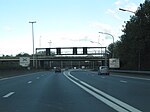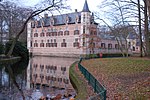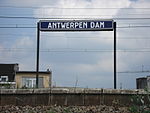Antwerpen-Noorderdokken railway station
Buildings and structures in AntwerpPublic transport in AntwerpRailway stations in AntwerpRailway stations in BelgiumRailway stations opened in 1974

Antwerp-Noorderdokken (English: Antwerp Northern Docks) is a railway station in the city of Antwerp, Antwerp, Belgium. The station opened on 26 May 1974 on the Antwerp–Lage Zwaluwe railway, known in Belgium as Line 12 and also Line 27A, a freight line to the port of Antwerp.
Excerpt from the Wikipedia article Antwerpen-Noorderdokken railway station (License: CC BY-SA 3.0, Authors, Images).Antwerpen-Noorderdokken railway station
Argentiniëlaan, Antwerp
Geographical coordinates (GPS) Address External links Nearby Places Show on map
Geographical coordinates (GPS)
| Latitude | Longitude |
|---|---|
| N 51.261388888889 ° | E 4.4277777777778 ° |
Address
Antwerpen-Noorderdokken
Argentiniëlaan
2030 Antwerp (Antwerp)
Antwerp, Belgium
Open on Google Maps










